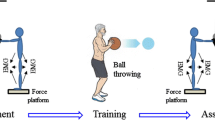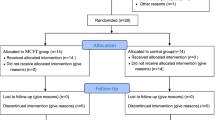Abstract
Purpose
The purpose of the study was to investigate the role of training in improvement of balance control in older adults with mild cognitive impairment.
Methods
Older adults (mean age 78) with mild cognitive impairment (MCI) and cognitively intact older adults (mean age 72) were exposed to self-initiated perturbations while performing bilateral shoulder flexion task before and after a single training session consisting of throwing a medicine ball. EMG activity of six trunk and lower limb muscles was recorded. Muscle onsets, integrals of EMG, and muscle co-contraction (C) and reciprocal (R) activation indices were calculated and analyzed during the anticipatory and compensatory phases of postural control.
Results
Anticipatory postural adjustments (APAs) were observed in both groups. Individuals with MCI, as compared to controls, had higher level of co-contraction of muscles. The training resulted in enhancement of the generation of APAs in individuals with MCI seen as earlier onset of leg and trunk muscle activity prior to the bilateral arm flexion task. While smaller co-contraction of muscles post-training was seen in both the groups, the effect of a single training session was significant in control subjects only.
Conclusions
The outcome of the exploratory study suggests that perturbation-based training could be used to improve balance control in older adults with and without mild cognitive impairment.




Similar content being viewed by others
References
Aruin A, Almeida G (1997) A coactivation strategy in anticipatory postural adjustments in persons with down syndrome. Mot Control 1:178–191
Aruin AS, Latash ML (1995a) Directional specificity of postural muscles in feed-forward postural reactions during fast voluntary arm movements. Exp Brain Res 103:323–332
Aruin AS, Latash ML (1995b) The role of motor action in anticipatory postural adjustments studied with self-induced and externally triggered perturbations. Exp Brain Res 106:291–300
Aruin AS, Kanekar N, Lee YJ, Ganesan M (2015) Enhancement of anticipatory postural adjustments in older adults as a result of a single session of ball throwing exercise. Exp Brain Res 233:649–655
Aruin AS, Ganesan M, Lee Y (2017) Improvement of postural control in individuals with multiple sclerosis after a single-session of ball throwing exercise. Mult Scler Relat Disord 17:224–229
Bahureksa L, Najafi B, Saleh A, Sabbagh M, Coon D, Mohler MJ, Schwenk M (2017) The impact of mild cognitive impairment on gait and balance: a systematic review and meta-analysis of studies using instrumented assessment. Gerontology 63:67–83
Basmajian JV (1980) Electromyography–dynamic gross anatomy: a review. Am J Anat 159:245–260
Bazalgette D, Zattara M, Bathien N, Bouisset S, Rondot P (1987) Postural adjustments associated with rapid voluntary arm movements in patients with Parkinson's disease. Adv Neurol 45:371–374
Bleuse S, Cassim F, Blatt JL, Labyt E, Derambure P, Guieu JD, Defebvre L (2006) Effect of age on anticipatory postural adjustments in unilateral arm movement. Gait Posture 24:203–210
Chen B, Lee YJ, Aruin AS (2017) Role of point of application of perturbation in control of vertical posture. Exp Brain Res 235:3449–3457
Claudino R, dos Santos EC, Santos MJ (2013) Compensatory but not anticipatory adjustments are altered in older adults during lateral postural perturbations. Clin Neurophysiol 124:1628–1637
Craig CE, Calvert GHM, Doumas M (2017) Effects of the availability of accurate proprioceptive information on older adults' postural sway and muscle co-contraction. Eur J Neurosci 46:2548–2556
Delbaere K, Kochan NA, Close JC, Menant JC, Sturnieks DL, Brodaty H, Sachdev PS, Lord SR (2012) Mild cognitive impairment as a predictor of falls in community-dwelling older people. Am J Geriatr Psychiatry 20:845–853
Deschamps T, Beauchet O, Annweiler C, Cornu C, Mignardot JB (2014) Postural control and cognitive decline in older adults: position versus velocity implicit motor strategy. Gait Posture 39:628–630
Diaz-Mardomingo MDC, Garcia-Herranz S, Rodriguez-Fernandez R, Venero C, Peraita H (2017) Problems in classifying mild cognitive impairment (MCI): One or multiple syndromes? Brain Sci 7:111
Dubois B, Albert ML (2004) Amnestic MCI or prodromal alzheimer's disease? Lancet Neurol 3:246–248
Fahn S, Marsden CD, Calne DB (1988) Dystonia 2. Raven Press, New York
Folstein MF, Folstein SE, McHugh PR (1975) "Mini-mental state". A practical method for grading the cognitive state of patients for the clinician. J Psychiatr Res 12:189–198
Franssen EH, Souren LE, Torossian CL, Reisberg B (1999) Equilibrium and limb coordination in mild cognitive impairment and mild Alzheimer's disease. J Am Geriatr Soc 47:463–469
Friedli WG, Hallett M, Simon SR (1984) Postural adjustments associated with rapid voluntary arm movements 1. Electromyographic data. J Neurol Neurosurg Psychiatry 47:611–622
Garland SJ, Stevenson TJ, Ivanova T (1997) Postural responses to unilateral arm perturbation in young, elderly, and hemiplegic subjects. Arch Phys Med Rehabil 78:1072–1077
Goyal N, Luna G, Curuk E, Aruin AS (2019) Role of motor and cognitive tasks in gait of individuals with mild cognitive impairment. Int J Rehabil Res 42:174
Hwang J, Lee S (2017) The effect of virtual reality program on the cognitive function and balance of the people with mild cognitive impairment. J Phys Ther Sci 29:1283–1286
Inglin B, Woollacott M (1988) Age-related changes in anticipatory postural adjustments associated with arm movements. J Gerontol 43:M105–113
Iwamoto Y, Takahashi M, Shinkoda K (2017) Differences of muscle co-contraction of the ankle joint between young and elderly adults during dynamic postural control at different speeds. J Physiol Anthropol 36:32
Jagdhane S, Kanekar N, Aruin AS (2016) The effect of a 4-week balance training program on anticipatory postural adjustments in older adults: a pilot feasibility study. Curr Aging Sci 9:295–300
Kanekar N, Aruin AS (2014a) Aging and balance control in response to external perturbations: role of anticipatory and compensatory postural mechanisms. Age (Dordr) 36:9621
Kanekar N, Aruin AS (2014b) The effect of aging on anticipatory postural control. Exp Brain Res 232:1127–1136
Kanekar N, Aruin AS (2015) Improvement of anticipatory postural adjustments for balance control: effect of a single training session. J Electromyogr Kinesiol 25:400–405
Kovacs E, Sztruhar Jonasne I, Karoczi CK, Korpos A, Gondos T (2013) Effects of a multimodal exercise program on balance, functional mobility and fall risk in older adults with cognitive impairment: a randomized controlled single-blind study. Eur J Phys Rehabil Med 49:639–648
Lam LC, Chau RC, Wong BM, Fung AW, Tam CW, Leung GT, Kwok TC, Leung TY, Ng SP, Chan WM (2012) A 1-year randomized controlled trial comparing mind body exercise (Tai Chi) with stretching and toning exercise on cognitive function in older Chinese adults at risk of cognitive decline. J Am Med Dir Assoc 13(568):e515–520
Lam FM, Huang MZ, Liao LR, Chung RC, Kwok TC, Pang MY (2018) Physical exercise improves strength, balance, mobility, and endurance in people with cognitive impairment and dementia: a systematic review. J Physiother 64:4–15
Latash M, Anson J (1996) What are normal movements in atypical populations? Behav Brain Sci 19:55–106
Latash ML, Aruin AS, Neyman I, Nicholas JJ (1995) Anticipatory postural adjustments during self inflicted and predictable perturbations in Parkinson's disease. J Neurol Neurosurg Psychiatry 58:326–334
Le Bozec S, Bouisset S (2004) Does postural chain mobility influence muscular control in sitting ramp pushes? Exp Brain Res 158:427–437
Lee YJ, Hoozemans MJ, van Dieen JH (2010) Oblique abdominal muscle activity in response to external perturbations when pushing a cart. J Biomech 43:1364–1372
Lee YJ, Chen B, Aruin AS (2015) Older adults utilize less efficient postural control when performing pushing task. J Electromyogr Kinesiol 25:966–972
Lopez MN, Charter RA, Mostafavi B, Nibut LP, Smith WE (2005) Psychometric properties of the folstein mini-mental state examination. Assessment 12:137–144
Man'kovskii NB, Mints A, Lysenyuk VP (1980) Regulation of the preparatory period for complex voluntary movement in old and extreme old age. Hum Physiol 6:46–50
Massion J (1992) Movement, posture and equilibrium: interaction and coordination. Prog Neurobiol 38:35–56
Nelson-Wong E, Appell R, McKay M, Nawaz H, Roth J, Sigler R, Third J, Walker M (2012) Increased fall risk is associated with elevated co-contraction about the ankle during static balance challenges in older adults. Eur J Appl Physiol 112:1379–1389
Park S, Horak FB, Kuo AD (2004) Postural feedback responses scale with biomechanical constraints in human standing. Exp Brain Res 154:417–427
Petersen RC, Smith GE, Waring SC, Ivnik RJ, Tangalos EG, Kokmen E (1999) Mild cognitive impairment: clinical characterization and outcome. Arch Neurol 56:303–308
Petersen RC, Roberts RO, Knopman DS, Geda YE, Cha RH, Pankratz VS, Boeve BF, Tangalos EG, Ivnik RJ, Rocca WA (2010) Prevalence of mild cognitive impairment is higher in men. The mayo clinic study of aging. Neurology 75:889–897
Pieruccini-Faria F, Sarquis-Adamson Y, Montero-Odasso M (2019) Mild cognitive impairment affects obstacle negotiation in older adults: results from "Gait and Brain Study". Gerontology 65:164–173
Portet F, Ousset PJ, Visser PJ, Frisoni GB, Nobili F, Scheltens P, Vellas B, Touchon J (2006) Mild cognitive impairment (MCI) in medical practice: a critical review of the concept and new diagnostic procedure. Report of the MCI working group of the european consortium on alzheimer's disease. J Neurol Neurosurg Psychiatry 77:714–718
Rogers MW, Kukulka CG, Soderberg GL (1992) Age-related changes in postural responses preceding rapid self-paced and reaction time arm movements. J Gerontol 47:M159–165
Santos MJ, Kanekar N, Aruin AS (2010a) The role of anticipatory postural adjustments in compensatory control of posture: 1 Electromyographic analysis. J Electromyogr Kinesiol 20:388–397
Santos MJ, Kanekar N, Aruin AS (2010b) The role of anticipatory postural adjustments in compensatory control of posture: 2 Biomechanical analysis. J Electromyogr Kinesiol 20:398–405
Schinkel-Ivy A, Duncan CA (2018) The effects of short-term and long-term experiences on co-contraction of lower extremity postural control muscles during continuous, multi-directional support-surface perturbations. J Electromyogr Kinesiol 39:42–48
Schwenk M, Sabbagh M, Lin I, Morgan P, Grewal GS, Mohler J, Coon DW, Najafi B (2016) Sensor-based balance training with motion feedback in people with mild cognitive impairment. J Rehabil Res Dev 53:945–958
Smith-Ray RL, Irmiter C, Boulter K (2016) Cognitive training among cognitively impaired older adults: a feasibility study assessing the potential improvement in balance. Front Public Health 4:219
Staube G, Wolf W (1999) Objective motor response onset detection in surface myoelectric sygnals. Med Eng Phys 21:449–467
Tombaugh TN, McIntyre NJ (1992) The mini-mental state examination: a comprehensive review. J Am Geriatr Soc 40:922–935
Vette AH, Sayenko DG, Jones M, Abe MO, Nakazawa K, Masani K (2017) Ankle muscle co-contractions during quiet standing are associated with decreased postural steadiness in the elderly. Gait Posture 55:31–36
Vliet EC, Manly J, Tang MX, Marder K, Bell K, Stern Y (2003) The neuropsychological profiles of mild Alzheimer's disease and questionable dementia as compared to age-related cognitive decline. J Int Neuropsychol Soc 9:720–732
Woollacott MH, Manchester DL (1993) Anticipatory postural adjustments in older adults: are changes in response characteristics due to changes in strategy? J Gerontol 48:M64–M70
Acknowledgements
We thank the study participants for their exceptional cooperation
Author information
Authors and Affiliations
Contributions
All authors contributed to the study conception and design. Material preparation, data collection, and analysis were performed by Yunju Lee and Nikita Goyal. The first draft of the manuscript was written by Yunju Lee and Alexander Aruin and all authors commented on previous versions of the manuscript. All authors read and approved the final manuscript.
Corresponding author
Ethics declarations
Conflict of interest
The authors declare no potential conflicts of interest with respect to the authorship and/or publication of this article.
Additional information
Communicated by Lori Ann Vallis.
Publisher's Note
Springer Nature remains neutral with regard to jurisdictional claims in published maps and institutional affiliations.
Rights and permissions
About this article
Cite this article
Lee, Y., Goyal, N., Luna, G. et al. Role of a single session of ball throwing exercise on postural control in older adults with mild cognitive impairment. Eur J Appl Physiol 120, 443–451 (2020). https://doi.org/10.1007/s00421-019-04289-1
Received:
Accepted:
Published:
Issue Date:
DOI: https://doi.org/10.1007/s00421-019-04289-1




